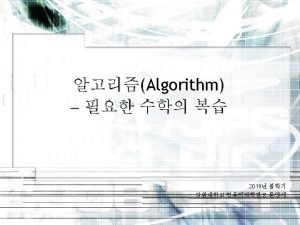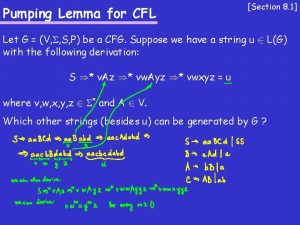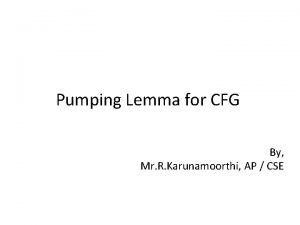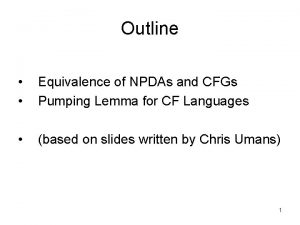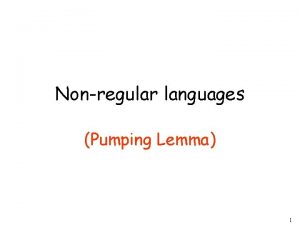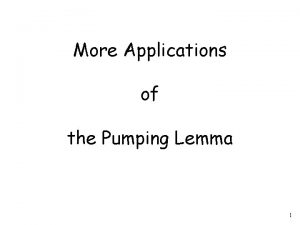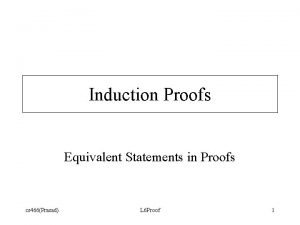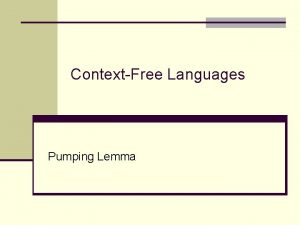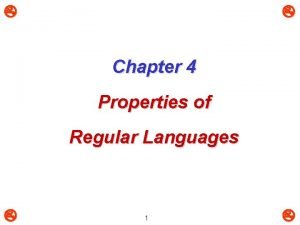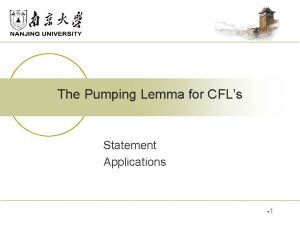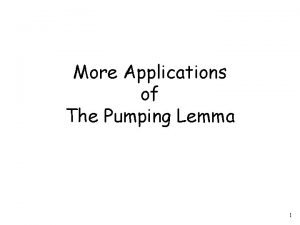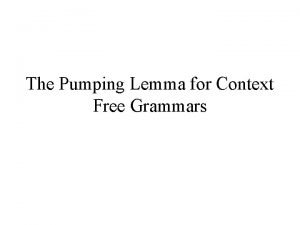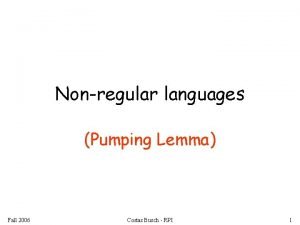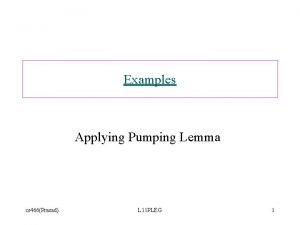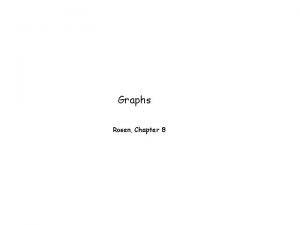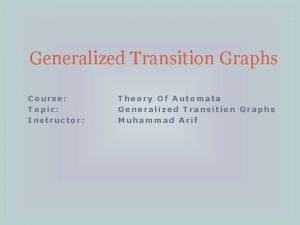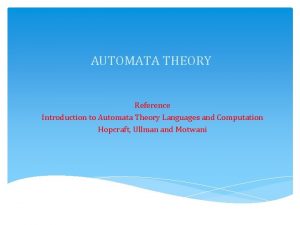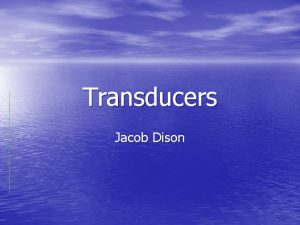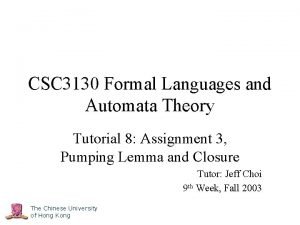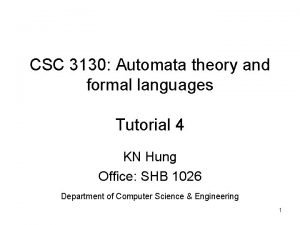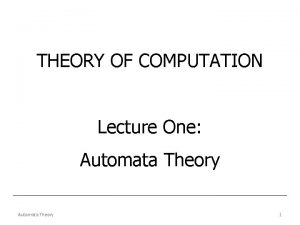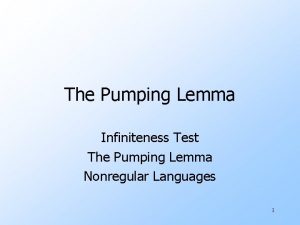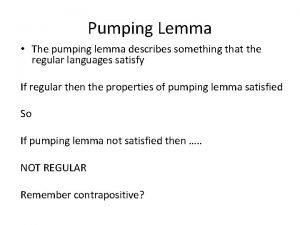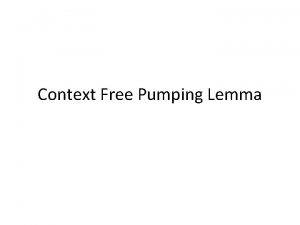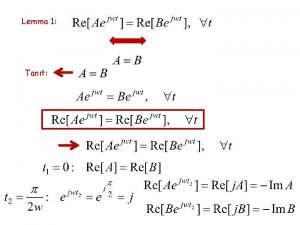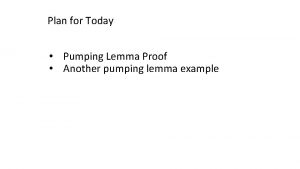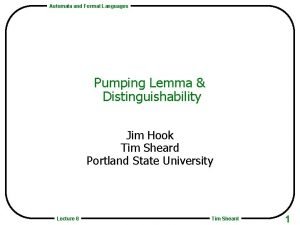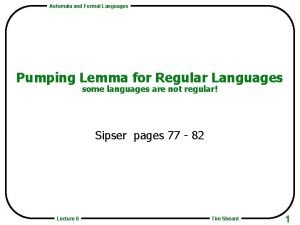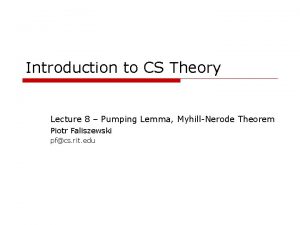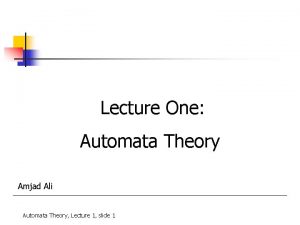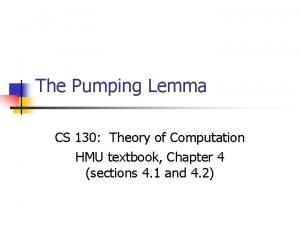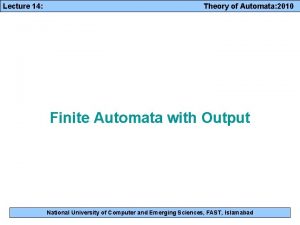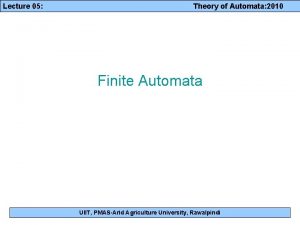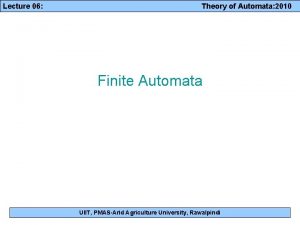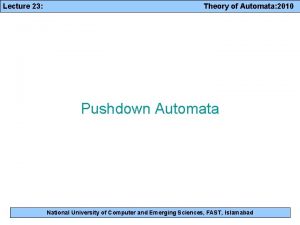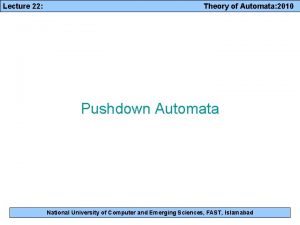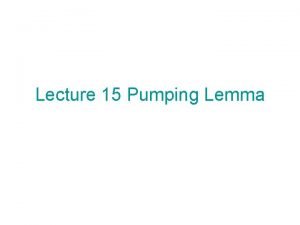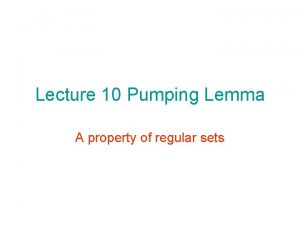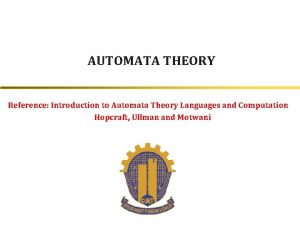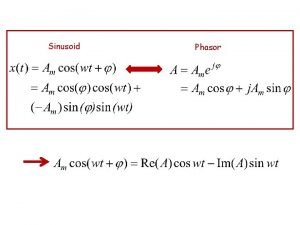Lecture 16 Theory of Automata 2010 Pumping Lemma























- Slides: 23

Lecture 16: Theory of Automata: 2010 Pumping Lemma National University of Computer and Emerging Sciences, FAST, Islamabad

Lecture 16: Theory of Automata: 2010 Introduction • By using FAs and regular expressions, we have been able to define many languages. Although these languages have many different structures, they take only a few basic forms: – Languages with required substrings – Languages that forbid some substrings – Languages that begin or end with certain substrings – Languages with certain even (or odd) properties, and so on. • We now turn our attention to some new forms, such as the language PALINDROME, or the language PRIME of all words ap, where p is a prime number. • We shall see that neither of these is a regular language. We can describe them in English, but they can not be defined by an FA. We need to build more powerful machines to define them. National University of Computer and Emerging Sciences, FAST, Islamabad 2

Lecture 16: Theory of Automata: 2010 Definition of Non-Regular Languages Definition: • A language that cannot be defined by a regular expression is called a non-regular language. Notes: – By Kleene’s theorem, a non-regular language can also not be accepted by any FA or TG. – All languages are either regular or non-regular; none are both. National University of Computer and Emerging Sciences, FAST, Islamabad 3

Lecture 16: Theory of Automata: 2010 Case Study • Consider the langugage L = {Λ; ab; aabb; aaabbb; aaaabbbb; aaaaabbbbb; …} • The language L can also be written as L = {anbn for n = 0; 1; 2; 3; …} or for short L = {anbn} • Note that although L is a subset of many regular languages, such as a*b*; the language defined by ab also includes such strings as aab and bb that are not in L. National University of Computer and Emerging Sciences, FAST, Islamabad 4

Lecture 16: Theory of Automata: 2010 Example • Suppose, it is required to prove that this language is nonregular. Let, contrary, L be a regular language then by Kleene’s theorem it must be accepted by an FA, say, F. • Since every FA has finite number of states then the language L (being infinite) accepted by F must have words of length more than the number of states. Which shows that, F must contain a circuit. • For the sake of convenience suppose that F has 10 states. Consider the word a 9 b 9 from the language L and let the path traced by this word be shown as: National University of Computer and Emerging Sciences, FAST, Islamabad 5

Lecture 16: Theory of Automata: 2010 Example National University of Computer and Emerging Sciences, FAST, Islamabad 6

Lecture 16: Theory of Automata: 2010 • But, looping the circuit generated by the states 3, 4, 6, 5, 3 with a-edges once more, F also accepts the word a 9+4 b 9, while a 13 b 9 is not a word in L. • It may also be observed that, because of the circuit discussed above, F also accepts the words a 9(a 4 )m b 9, m = 1, 2, 3, … • F accepts the words a 9(a 4 )m b 9(b 2 )n where m, n=0, 1, 2, 3, …(m and n not being simultaneously 0). Which shows that F accepts words that are not belonging to L. National University of Computer and Emerging Sciences, FAST, Islamabad 7

Lecture 16: Theory of Automata: 2010 • Thus there is no FA which accepts the language L. which shows, by Kleene’s theorem, that the language L can’t be expressed by any regular expression. It may be noted that apparently anbn seems to be a regular expression of L, but in fact it is not. • The observations made from this example, generalize theorem (also called the Pumping lemma) regarding the infinite regular language as follows: National University of Computer and Emerging Sciences, FAST, Islamabad 8

Lecture 16: Theory of Automata: 2010 Theorem 13 • Let L be any regular language that has infinitely many words. Then there exist some three strings x, y, and z (where y is not the null string) such that all the strings of the form xynz for n = 1, 2, 3, … are words in L. National University of Computer and Emerging Sciences, FAST, Islamabad 9

Lecture 16: Theory of Automata: 2010 Proof of theorem 13 • Since L is regular, there is an FA that accepts exactly the words in L. • Let w be some word in L that has more letters than there are states in FA. • When w generates a path through the machine, the path cannot visit a new state for each letter read, because there are more letters than states. Therefore, the path must at some point revisit a state that it has already visited. In other words, the path contains a circuit in it. National University of Computer and Emerging Sciences, FAST, Islamabad 10

Lecture 16: Theory of Automata: 2010 Proof of theorem 13 contd. Let’s break the word w up into 3 parts: 1. Part 1: Starting at the beginning, let x denote all the letters of w that lead up to the first state that is revisited. Note that x may be the null string if the path revisits the start state as its first revisit. 2. Part 2: Starting at the letter after the substring x, let y denote the substring of w that travels around the circuit coming back to the same state the circuit began with. Because there must be a circuit, y cannot be the null string, and y contains the letters of w for exactly one loop around this circuit. 3. Part 3: Let z be the rest of w, starting at the letter after y and going to the end of the string w. Note that z could be null, or the path for z could also loop around the y-circuit or any other. That means that what z does is arbitrary. • Clearly, from the definitions of these substrings, we have w = xyz. Recall that w is accepted by the FA. National University of Computer and Emerging Sciences, FAST, Islamabad 11

Lecture 16: Theory of Automata: 2010 Proof of Theorem 13 contd. • What is the path for the input string xyyz? • This path follows the path for w in the first part x and leads up to the beginning of the place where w looped around a circuit. • Then like w, it inputs the substring y, which causes the machine to loop back to this same state again. • Then, again like w, it inputs the substring y, which causes the machine to loop back to this same state another time. • Finally, just like w, it proceeds along the path dictated by the substring z and ends at the same final state that w did. • Hence, the string xyyz is accepted by this machine and therefore must be in the language L. National University of Computer and Emerging Sciences, FAST, Islamabad 12

Lecture 16: Theory of Automata: 2010 Proof of Theorem 13 contd. • Similarly, the strings xyyyz, xyyyyz, . . . must also be in L. • In other words, L must contain all strings of the form: xynz for n = 1; 2; 3; … National University of Computer and Emerging Sciences, FAST, Islamabad 13

Lecture 16: Theory of Automata: 2010 Example • Consider the following FA that accepts an infinite language and has only six states: • Consider the word w = bbbababa National University of Computer and Emerging Sciences, FAST, Islamabad 14

Lecture 16: Theory of Automata: 2010 Example contd. • The x-part goes from the - state up to the first circuit: substring b • The y-part goes around the circuit consisting of states 2, 3, and 5: substring bba • The z-part is substring baba • What happens to the input string xyyz = (b)(bba)(baba)? • This string will loop twice around the circuit and is accepted. • The same thing happens with xyyyz, xyyyyz, and in general, for xynz. National University of Computer and Emerging Sciences, FAST, Islamabad 15

Lecture 16: Theory of Automata: 2010 • Let us use Theorem 13 to show again that the language L = {anbn} is not regular. • If L is regular then Theorem 13 says that there must be strings x, y, and z such that all words of the form xynz are in L. • A typical word of L looks like this: aaa…aaaabbbb…bbb. How to break it into x, y, and z? • If y contains entirely a’s, then we pump it to xyyz, this string will have more a’s than b’s, which is not allowed in L. • Similarly, if y is composed of only b’s then xyyz will have more b’s than a’s, and is not allowed in L either. National University of Computer and Emerging Sciences, FAST, Islamabad 16

Lecture 16: Theory of Automata: 2010 • If y have some a’s followed by some b’s then y must contain the substring ab. – So, xyyz must have 2 substrings ab’s. – But every word in L has exactly one substring ab. – Therefore, xyyz can not be a word in L. • The above arguments show that the pumping lemma cannot apply to L and therefore L is not regular. National University of Computer and Emerging Sciences, FAST, Islamabad 17

Lecture 16: Theory of Automata: 2010 Example • Let EQUAL be the language of all words (over the alphabet ∑ = {a; b}) that have the same total number of a’s and b’s: • EQUAL = {Λ; ab; ba; aabb; abab; abba; baab; baba; bbaa; aaabbb; …} • Can you show that EQUAL is not regular? • Let L = {anban} = {b; aba; aabaa; …} • Can you show that L is not regular? National University of Computer and Emerging Sciences, FAST, Islamabad 18

Lecture 16: Theory of Automata: 2010 Theorem 14 • Let L be an infinite language accepted by a finite automaton with N states. Then, for all words w in L that have more than N letters, there are strings x, y, and z, where y is not null and length(x) + length(y) does not exceed N, such that w = xyz and all strings of the form xynz for n = 1; 2; 3; … are in L. • This is obviously just another version of Theorem 13 (the pumping lemma), for which we have already provided the proof. • The purpose of stressing the issue of lengths is illustrated in the following example. National University of Computer and Emerging Sciences, FAST, Islamabad 19

Lecture 16: Theory of Automata: 2010 Example • We will show that the language PALINDROME is not regular. • We cannot use the first version of the pumping lemma (Theorem 13)vbecause the strings x = a; y = b; z = a satisfy the lemma and do not contradict the language, since all the strings of the form xynz = abna are words in PALINDROME. • So, we will use the second version of the pumping lemma (Theorem 14) to show that PALINDROME is nonregular. National University of Computer and Emerging Sciences, FAST, Islamabad 20

Lecture 16: Theory of Automata: 2010 Example contd. • Suppose for the contrary that PALINDROME were regular, then there would exist some FA that accepts it. • For the sake of argument, assume that this FA has 77 states. • Then, the palindrome w = a 80 ba 80 must be accepted by this FA. • Because w has more letters than the FA has states, by Theorem 14 we can break w into three parts: x, y, and z. • Since length(x) + length(y) ≤ 77 (by Theorem 14), the strings x and y must both be made of all a’s, since the first 77 letters of w are all a’s. National University of Computer and Emerging Sciences, FAST, Islamabad 21

Lecture 16: Theory of Automata: 2010 • Hence, when we form xyyz, we are adding more a’s to the front of w, but we are not adding more a’s to the back of w. • Thus, the string xyyz will be of the form a(more than 80)ba 80 and obviously is NOT a palindrome. • This is a contradiction, since Theorem 14 says that xyyz must be a palindrome. Hence, the language PALINDROME is NOT regular. National University of Computer and Emerging Sciences, FAST, Islamabad 22

Lecture 16: Theory of Automata: 2010 Example • Consider the language PRIME = {ap where p is a prime} • Recall that a prime is a positive integer greater than 1 whose only positive divisors are 1 and itself, for example 2, 3, 5, 7. . . • Hence, PRIME = {ap where p is a prime} = {aa; aaaaa; aaaaaaa; …} • Can you show that PRIME is non-regular? National University of Computer and Emerging Sciences, FAST, Islamabad 23
 펌핑 보조정리
펌핑 보조정리 Pumping lemma for cfl examples
Pumping lemma for cfl examples Pumping lemma for cfg examples
Pumping lemma for cfg examples Pumping lemma 예제
Pumping lemma 예제 Pumping lemma non regular languages examples
Pumping lemma non regular languages examples Applications of pumping lemma
Applications of pumping lemma Proofs
Proofs Pumping lemma of cfl
Pumping lemma of cfl Regular language
Regular language Pumping lemma for cfls
Pumping lemma for cfls Pumping lemma for cfls
Pumping lemma for cfls Applications of pumping lemma
Applications of pumping lemma Chomsky
Chomsky Pumping lemma pigeonhole principle
Pumping lemma pigeonhole principle Contradiction in math
Contradiction in math Handshaking lemma
Handshaking lemma 01:640:244 lecture notes - lecture 15: plat, idah, farad
01:640:244 lecture notes - lecture 15: plat, idah, farad Gtg
Gtg Central concepts of automata theory in flat
Central concepts of automata theory in flat Bidirectional transducers in automata theory
Bidirectional transducers in automata theory Automata theory tutorial
Automata theory tutorial Automata theory tutorial
Automata theory tutorial Csc3120 datasheet
Csc3120 datasheet Automata theory
Automata theory
